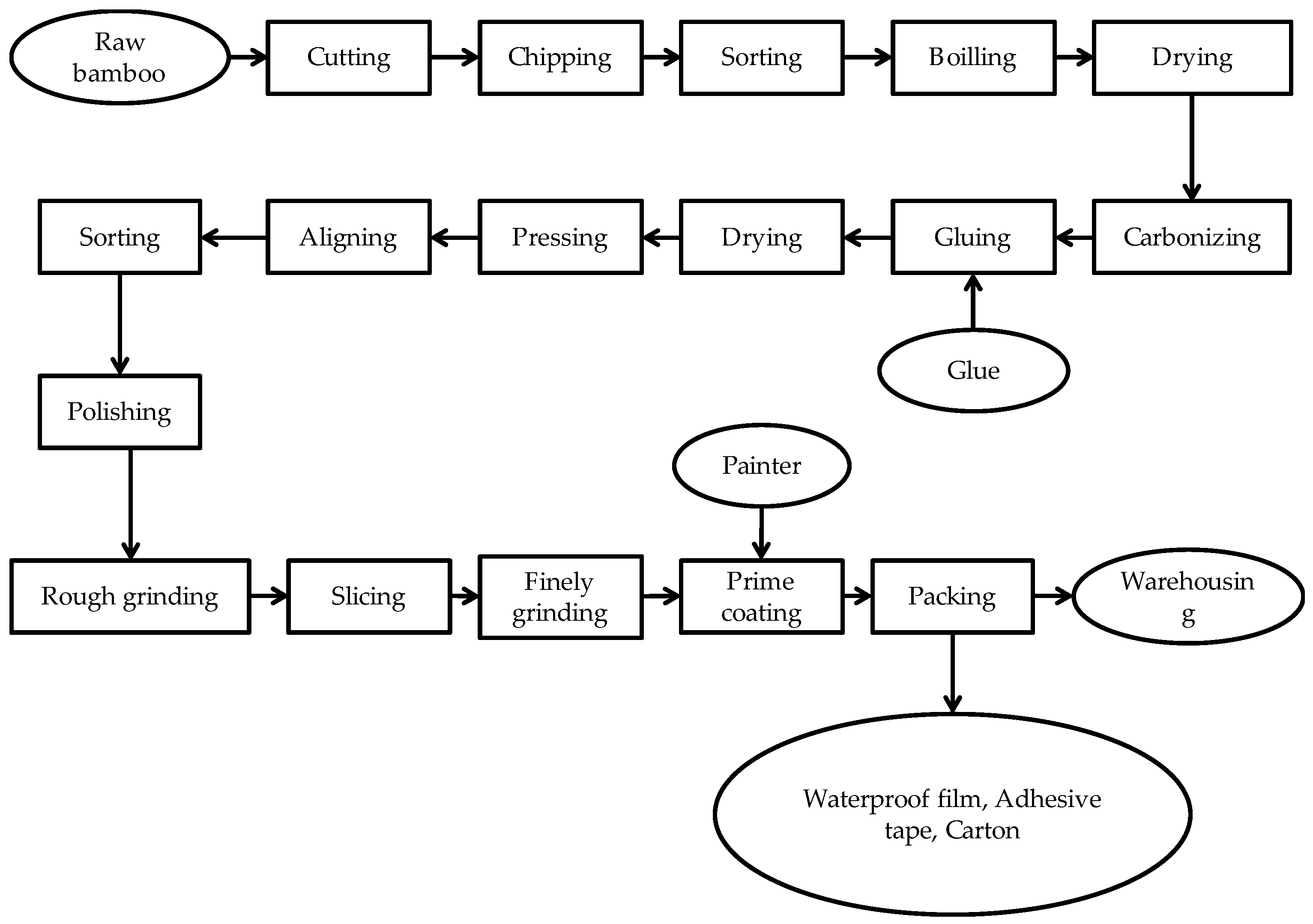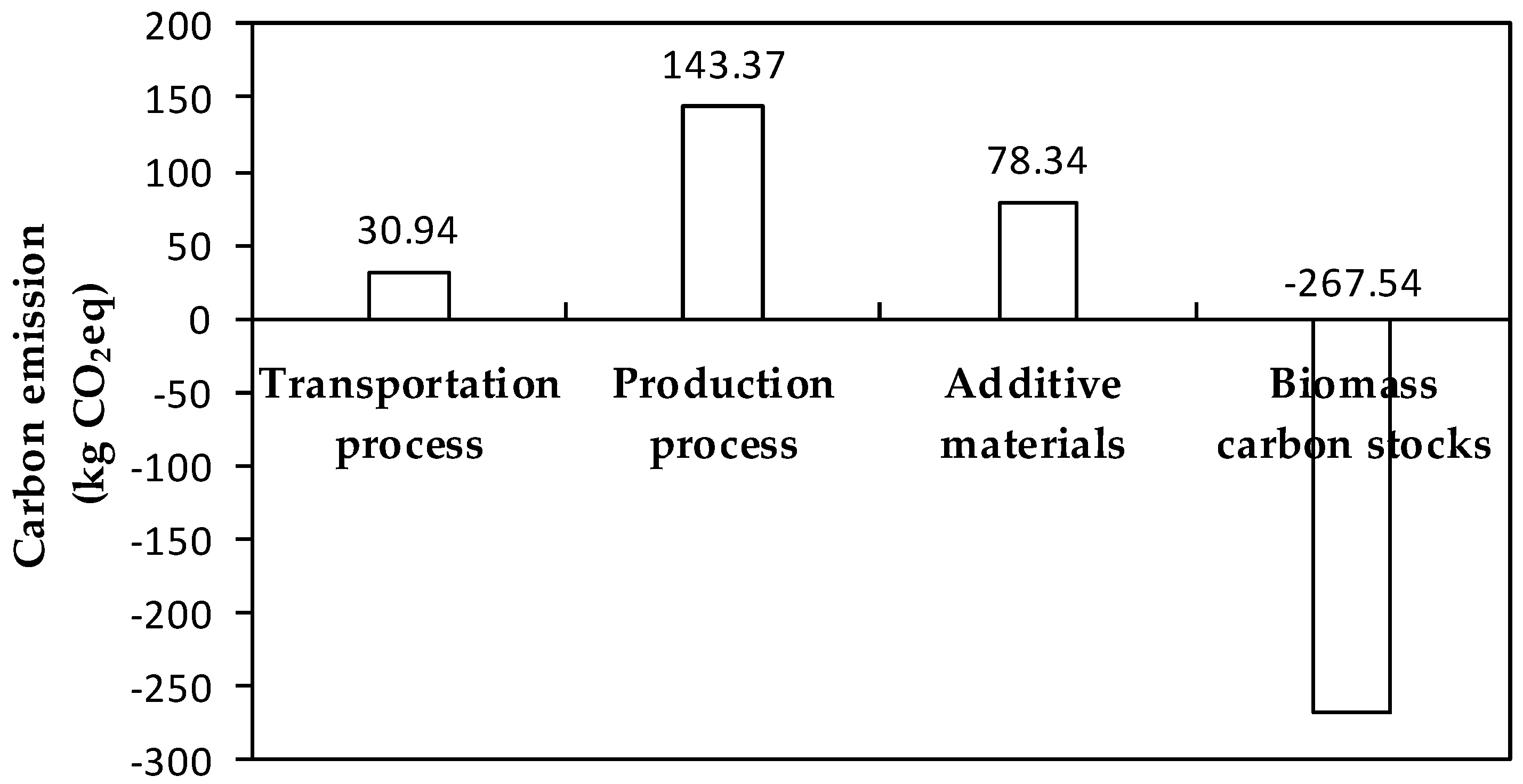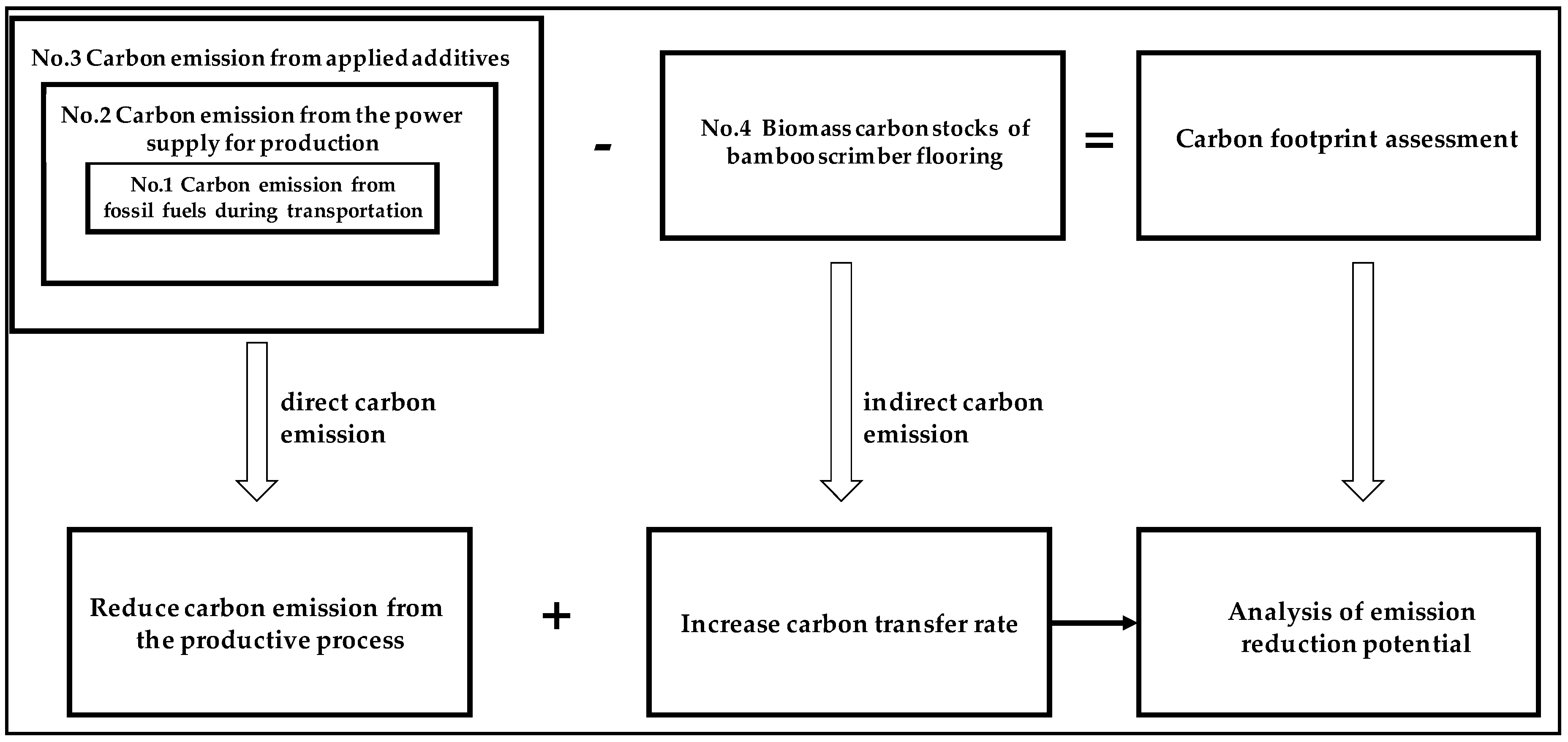Carbon Footprint Analysis of Bamboo Scrimber Flooring—Implications for Carbon Sequestration of Bamboo Forests and Its Products
Abstract
:1. Introduction
2. Materials and Methods
2.1. Study Area and Objective
2.2. Criteria and Boundaries for Assessment
2.3. Sketch of the Production Process
2.4. Data Collection and Carbon Footprint Assessment
2.4.1. Carbon Emission from Transportation
2.4.2. Carbon Emission from Production
2.4.3. Carbon Emission from Additive Materials
2.4.4. Biomass Carbon Stock
2.5. Carbon Footprint of Bamboo Scrimber Flooring
3. Results
3.1. Carbon Emission from Fossil Fuels during Transportation
3.2. Carbon Emission from the Power Supply for Production
3.3. Carbon Emission from Applied Additives
3.4. Biomass Carbon Stocks
3.5. Carbon Footprint Assessment for Produce 1 m3 of Bamboo Scrimber Flooring
4. Discussion
4.1. Analysis of Carbon Emission Reduction Potentials
4.1.1. Carbon Emission from Transportation
4.1.2. Carbon Emission during the Production Processes
4.1.3. Carbon Emission from Additive Materials
4.1.4. Effect of Carbon Stock in Bamboo Products
4.2. The Implication for Bamboo Forests Carbon Sequestration
4.3. Uncertainty Analysis
5. Conclusions
Author Contributions
Acknowledgments
Conflicts of Interest
Appendix A
| Type of Dataset | Investigated Objects | Measurable Factors | Data Sources |
|---|---|---|---|
| Fuel energy | Gasoline and diesel used for transportation | Weight of gasoline or diesel for transporting per 1 kg material per 100 km distance (kg km−1); weight of transported materials (kg); transportation distance (kg); carbon emission factors for gasoline and diesel | Carbon emission factors for gasoline and diesel refer to IPCC EFDB (https://www.ipcc-nggip.iges.or.jp/EFDB/main.php), and other measurable factors were provided by Dasso company |
| Electric energy | Electric energy consumed during production processes | Rated power of machine; idle and operation time of applied machines; carbon emission factors for electricity | Carbon emission factors for electricity refer to East China Power Grid of National Development and Reform Commission, and other measurable factors were investigated by authors. |
| Carbon emission from applied additives | Glue, oil paint, and cartoon, etc. used during production processes. | The quantity of applied additives for producing 1 m3 of bamboo flooring; carbon emission factor for each additive | Quantity of applied additives was measured. Carbon emission factors for additives refer to IPCC EFDB. |
| Biomass carbon stock in products | Carbon stock in bamboo scrimber flooring transferred from raw bamboo culm | Carbon transfer ratio during production processes; dry weight of the bamboo flooring; carbon density. | Carbon stock of bamboo flooring was measured, and carbon transfer ratio was derived from carbon stocks of bamboo flooring and raw bamboo culm. Carbon density of raw bamboo culm refers to Zhou (2006). |
References
- Brito de Figueirêdo, M.C.; Kroeze, C.; Potting, J.; da Silva Barros, V.; Sousa de Aragão, F.A.; Gondim, R.S.; de Lima Santos, T.; de Boer, I.J.M. The carbon footprint of exported brazilian yellow melon. J. Clean. Prod. 2013, 47, 404–414. [Google Scholar] [CrossRef]
- Pattara, C.; Raggi, A.; Cichelli, A. Life cycle assessment and carbon footprint in the wine supply-chain. Environ. Manag. 2012, 49, 1247–1258. [Google Scholar] [CrossRef] [PubMed]
- Boguski, T.K. Life cycle carbon footprint of the national geographic magazine. Int. J. Life Cycle Assess. 2010, 15, 635–643. [Google Scholar] [CrossRef]
- Akbari, S.; Nurul Habib, K. Oil vulnerability in the greater toronto area: Impacts of high fuel prices on urban form and environment. Int. J. Environ. Sci. Technol. 2014, 11, 2347–2358. [Google Scholar] [CrossRef]
- Li, J.; Shi, H. Research on improvement of product carbon footprint measurement system based on internet of things (in Chinese). Sci. Technol. Prog. Policy 2014, 4, 6–10. [Google Scholar]
- Quinteiro, P.; Araújo, A.; Oliveira, B.; Dias, A.C.; Arroja, L. The carbon footprint and energy consumption of a commercially produced earthenware ceramic piece. J. Eur. Ceram. Soc. 2012, 32, 2087–2094. [Google Scholar] [CrossRef]
- Demertzi, M.; Paulo, J.A.; Arroja, L.; Dias, A.C. A carbon footprint simulation model for the cork oak sector. Sci. Total Environ. 2016, 566–567, 499–511. [Google Scholar] [CrossRef] [PubMed]
- Demertzi, M.; Paulo, J.A.; Faias, S.P.; Arroja, L.; Dias, A.C. Evaluating the carbon footprint of the cork sector with a dynamic approach including biogenic carbon flows. Int. J. Life Cycle Assess. 2018, 23, 1448–1459. [Google Scholar] [CrossRef]
- Dias, A.C.; Arroja, L. Comparison of methodologies for estimating the carbon footprint—Case study of office paper. J. Clean. Prod. 2012, 24, 30–35. [Google Scholar] [CrossRef]
- Salahuddin, M.; Alam, K.; Ozturk, I. Is rapid growth in internet usage environmentally sustainable for Australia? An empirical investigation. Environ. Sci. Pollut. Res. 2016, 23, 4700–4713. [Google Scholar] [CrossRef] [PubMed]
- Zhang, Q.; Zheng, D.; Xu, X.S. Factor decomposition study on the change of ecological pressure of China’s energy carbon footprint. Arid Area Resour. Environ. 2015, 29, 41–46. [Google Scholar]
- Cornejo, P.K.; Zhang, Q.; Mihelcic, J.R. Quantifying benefits of resource recovery from sanitation provision in a developing world setting. J. Environ. Manag. 2013, 131, 7–15. [Google Scholar] [CrossRef] [PubMed]
- Weinzettel, J.; Steen-Olsen, K.; Hertwich, E.G.; Borucke, M.; Galli, A. Ecological footprint of nations: Comparison of process analysis, and standard and hybrid multiregional input–output analysis. Ecol. Econ. 2014, 101, 115–126. [Google Scholar] [CrossRef]
- Gratani, L.; Crescente, M.L.; Fabrini, G.; Digiulio, E. Growth pattern and photosynthetic activity of different bamboo species growing in the botanical garden of Rome. Flora 2008, 203, 77–84. [Google Scholar] [CrossRef]
- Li, Z.; Kobayashi, M. Plantation future of bamboo in China. J. For. Res. 2004, 15, 233–242. [Google Scholar] [CrossRef]
- FAO. Global Forest Resources Assessment 2010: Main Report; Food and Agriculture Organization of the United Nations: Rome, Italy, 2010. [Google Scholar]
- SFAPRC. Forest Resources in China—The 8th National Forest Inventory; State Forestry Administration: Beijing, China, 2015.
- Song, X.Z.; Zhou, G.; Jiang, H.; Yu, S.Q.; Fu, J.H.; Li, W.Z.; Wang, W.F.; Ma, Z.H.; Peng, C.H. Carbon sequestration by Chinese bamboo forests, and their ecological benefits: Assessment of potential, problems, and future challenges. Environ. Rev. 2011, 19, 418–428. [Google Scholar] [CrossRef]
- Yen, T.M. Comparing aboveground structure and aboveground carbon storage of an age series of moso bamboo forests subjected to different management strategies. J. For. Res. 2015, 20, 1–8. [Google Scholar] [CrossRef]
- Yen, T.M. Culm height development, biomass accumulation and carbon storage in an initial growth stage for a fast-growing moso bamboo (Phyllostachy pubescens). Bot. Stud. 2016, 57, 10. [Google Scholar] [CrossRef] [PubMed]
- Yen, T.M.; Lee, J.S. Comparing aboveground carbon sequestration between moso bamboo (Phyllostachys heterocycla) and china fir (Cunninghamia lanceolata) forests based on the allometric model. For. Ecol. Manag. 2011, 261, 995–1002. [Google Scholar] [CrossRef]
- Eastday.com. In 2015, the Output Value of China’s Bamboo Industry Was Nearly 200 Billion Yuan. 2016. Available online: https://finance.sina.cn/stock/jdts/2016-10-13/detail-ifxwvpqh7348217.d.html (accessed on 13 October 2016).
- Lobovikov, M.; Paudel, S.; Piazza, M. World Bamboo Resources: A Thematic Study Prepared in the Framework of the Global Forest Resources Assessment 2005; Food and Agriculture Organization of the United Nation: Rome, Italy, 2007; pp. 1–81. [Google Scholar]
- Network, C.F. Bamboo Flooring Market Analysis: 60% to 70% of Production Exports. 2017. Available online: http://www.chinafloor.cn/ (accessed on 21 November 2017).
- The Intergovernmental Panel on Climate Change. EFDB Emission Factor Database. 2016. Available online: https://www.ipcc-nggip.iges.or.jp/EFDB/main.php (accessed on 20 September 2016).
- Zhou, G.M. Carbon Storage, Fixation and Distribution in Moso Bamboo (Phyllostachy pubescens) Stands Ecosystem. Ph.D. Thesis, Zhejiang University, Hangzhou, China, 1 April 2006. [Google Scholar]
- Du, H.Q.; Zhou, G.M.; Ge, H.L.; Fan, W.Y.; Xu, X.J.; Fan, W.L.; Shi, Y.J. Satellite-based carbon stock estimation for bamboo forest with a non-linear partial least square regression technique. Int. J. Remote Sens. 2012, 33, 1917–1933. [Google Scholar] [CrossRef]
- Han, N.; Du, H.; Zhou, G.; Xu, X.; Cui, R.; Gu, C. Spatiotemporal heterogeneity of moso bamboo aboveground carbon storage with landsat thematic mapper images: A case study from Anji County, China. Int. J. Remote Sens. 2013, 34, 4917–4932. [Google Scholar] [CrossRef]
- Du, H.Q.; Zhou, G.M.; Fan, W.Y.; Ge, H.L.; Xu, X.J.; Shi, Y.J.; Fan, W.L. Spatial heterogeneity and carbon contribution of aboveground biomass of moso bamboo by using geostatistical theory. Plant Ecol. 2009, 207, 131–139. [Google Scholar] [CrossRef]
- Xu, X.J.; Du, H.Q.; Zhou, G.M.; Ge, H.L.; Shi, Y.J.; Zhou, Y.F.; Fan, W.L.; Fan, W.Y. Estimation of aboveground carbon stock of moso bamboo (Phyllostachys heterocycla var. Pubescens) forest with a landsat thematic mapper image. Int. J. Remote Sens. 2011, 32, 1431–1448. [Google Scholar] [CrossRef]
- Shang, Z.; Zhou, G.; Du, H.; Xu, X.; Shi, Y.; Lü, Y.; Zhou, Y.; Gu, C. Moso bamboo forest extraction and aboveground carbon storage estimation based on multi-source remotely sensed images. Int. J. Remote Sens. 2013, 34, 5351–5368. [Google Scholar] [CrossRef]
- Li, X.J.; Mao, F.J.; Du, H.Q.; Zhou, G.M.; Xu, X.J.; Han, N.; Sun, S.B.; Gao, G.L.; Chen, L. Assimilating leaf area index of three typical types of subtropical forest in china from modis time series data based on the integrated ensemble kalman filter and prosail model. ISPRS J. Photogram. Remote Sens. 2017, 126, 68–78. [Google Scholar] [CrossRef]
- Xu, X.J.; Du, H.Q.; Zhou, G.M.; Mao, F.J.; Li, P.H.; Fan, W.L.; Zhu, D.E. A method for daily global solar radiation estimation from two instantaneous values using modis atmospheric products. Energy 2016, 111, 117–125. [Google Scholar] [CrossRef]
- Song, X.Z.; Chen, X.F.; Zhou, G.M.; Jiang, H.; Peng, C.H. Observed high and persistent carbon uptake by moso bamboo forests and its response to environmental drivers. Agric. For. Meteorol. 2017, 247, 467–475. [Google Scholar] [CrossRef]
- Xu, X.J.; Zhou, G.M.; Liu, S.G.; Du, H.Q.; Mo, L.F.; Shi, Y.J.; Jiang, H.; Zhou, Y.F.; Liu, E.B. Implications of ice storm damages on the water and carbon cycle of bamboo forests in southeastern China. Agric. For. Meteorol. 2013, 177, 35–45. [Google Scholar] [CrossRef]
- Xu, X.J.; Du, H.Q.; Zhou, G.M.; Li, P.H.; Shi, Y.J.; Zhou, Y.F. Eddy covariance analysis of the implication of drought on the carbon fluxes of moso bamboo forest in southeastern china. Trees 2016, 30, 1807–1820. [Google Scholar] [CrossRef]
- Van der Lugt, P.; Vogtlander, J. The Environmental Impact of Industrial Bamboo Products—Life-Cycle Assessment and Carbon Sequestration; Report Number: INBAR Technical Report 35; International Network for Bamboo and Rattan (INBAR): Beijing, China, 2015. [Google Scholar]



| Transported Material | Fuel | Fuel Consumption (L t−1 km−1) | Distance (km) | Weight (kg m−3) | Carbon Emission Factor of Fuel (kg L−1) | CO2 Emission Equivalent (kg m−3) | Proportion of CO2 Emission (%) |
|---|---|---|---|---|---|---|---|
| Bamboo culms | Diesel | 0.015 | 55 | 2686.09 | 2.63 | 5.83 | 18.83 |
| Bamboo board | Diesel | 0.015 | 550 | 1115.27 | 2.63 | 24.20 | 78.20 |
| Glue | Gasoline | 0.018 | 200 | 108.06 | 2.3 | 0.89 | 3.19 |
| Oil paint | Gasoline | 0.015 | 200 | 1.47 | 2.3 | 0.01 | 0.03 |
| Carton | Gasoline | 0.020 | 15 | 14.34 | 2.3 | 0.01 | 0.03 |
| Total | 30.94 | 100 |
| Process | Power (kw) | Plank Operation−1 | Operation Time (s) | Idle Time (s) | Power Consumption (Kwh plank−1) | CO2 Emission Equivalent (kg plank−1) | CO2 Emission Equivalent (kg m−3) | Proportion of CO2 Emission (%) |
|---|---|---|---|---|---|---|---|---|
| Cutting | 4.5 | 1 | 13.3 | 33.3 | 0.0208 | 0.0174 | 3.4104 | 2.38 |
| Chipping | 4 | 1 | 13.3 | 13.3 | 0.0140 | 0.0117 | 2.2932 | 1.60 |
| Sorting | 6.3 | 1 | 66.6 | 33.3 | 0.0991 | 0.0829 | 16.2884 | 11.36 |
| Boiling | 9.6 | 1 | 66.6 | 33.3 | 0.1510 | 0.1263 | 24.7548 | 17.27 |
| Drying | 3 | 17,400 | 259,200 | / | 0.0093 | 0.0078 | 1.5288 | 1.07 |
| Carbonizing | 1.5 | 14,545 | 46,800 | / | 0.0010 | 0.0008 | 0.1568 | 0.11 |
| Gluing | / | / | / | / | / | / | / | / |
| Drying | 3 | 14,800 | 12,600 | 0.0005 | 0.0004 | 0.0784 | 0.05 | |
| Pressing | 31.8 | 3 | 80 | 60 | 0.2120 | 0.1774 | 34.7704 | 24.25 |
| Aligning | 52 | 6 | 50 | 60 | 0.1192 | 0.0997 | 19.5412 | 13.63 |
| Polishing | 22.5 | 1 | 10 | 3 | 0.0506 | 0.0424 | 8.3104 | 5.80 |
| Rough grinding | 37 | 5 | 50 | 30 | 0.0894 | 0.0748 | 14.6608 | 10.23 |
| Slicing | 10 | 1 | 6 | 3 | 0.0142 | 0.0119 | 2.3324 | 1.63 |
| Finely grinding | 38 | 5 | 50 | 30 | 0.0918 | 0.0768 | 15.0528 | 10.50 |
| Prime coating | 1.5 | 1 | 3 | 3 | 0.0012 | 0.0010 | 0.1960 | 0.14 |
| Total | / | / | / | / | 0.87 | 0.73 | 143.37 | 100 |
| Process | Additive | EF (kg CO2 eq kg−1) | Weight (kg) | Carbon Emission (kg) | Ratio (%) |
|---|---|---|---|---|---|
| Gluing | Glue | 0.6 | 108.06 | 64.84 | 82.77 |
| Painting | Paint | 0.6 | 0.98 | 0.59 | 0.75 |
| Packing | Carton | 0.9 | 14.34 | 12.91 | 16.48 |
| Total | 78.34 | 100 |
© 2019 by the authors. Licensee MDPI, Basel, Switzerland. This article is an open access article distributed under the terms and conditions of the Creative Commons Attribution (CC BY) license (http://creativecommons.org/licenses/by/4.0/).
Share and Cite
Gu, L.; Zhou, Y.; Mei, T.; Zhou, G.; Xu, L. Carbon Footprint Analysis of Bamboo Scrimber Flooring—Implications for Carbon Sequestration of Bamboo Forests and Its Products. Forests 2019, 10, 51. https://doi.org/10.3390/f10010051
Gu L, Zhou Y, Mei T, Zhou G, Xu L. Carbon Footprint Analysis of Bamboo Scrimber Flooring—Implications for Carbon Sequestration of Bamboo Forests and Its Products. Forests. 2019; 10(1):51. https://doi.org/10.3390/f10010051
Chicago/Turabian StyleGu, Lei, Yufeng Zhou, Tingting Mei, Guomo Zhou, and Lin Xu. 2019. "Carbon Footprint Analysis of Bamboo Scrimber Flooring—Implications for Carbon Sequestration of Bamboo Forests and Its Products" Forests 10, no. 1: 51. https://doi.org/10.3390/f10010051
APA StyleGu, L., Zhou, Y., Mei, T., Zhou, G., & Xu, L. (2019). Carbon Footprint Analysis of Bamboo Scrimber Flooring—Implications for Carbon Sequestration of Bamboo Forests and Its Products. Forests, 10(1), 51. https://doi.org/10.3390/f10010051





